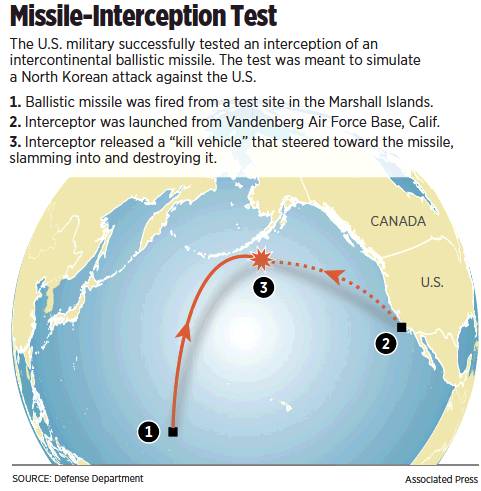U.S. declares missile-intercept test a success
A mock warhead was destroyed over the Pacific Ocean, marking a critical milestone toward defense.
By Robert Burns ASSOCIATED PRESS
WASHINGTON — The Pentagon scored an important success Tuesday in a test of its oft-criticized missile defense program, destroying a mock warhead over the Pacific Ocean with an interceptor that is key to protecting U.S. territory from a North Korean attack.
Vice Adm. Jim Syring, director of the Pentagon agency in charge of developing the missile-defense system, called the test result “an incredible accomplishment” and a critical milestone for a program hampered by setbacks over the years.
“This system is vitally important to the defense of our homeland, and this test demonstrates that we have a capable, credible deterrent against a very real threat,” Syring said in a statement announcing the test result.
Despite the success, the $244 million test didn’t confirm that under wartime conditions the United States could intercept an intercontinental-range missile fired by North Korea. Pyongyang is understood to be moving closer to the capability of putting a nuclear warhead on such an ICBM and could develop decoys sophisticated enough to trick an interceptor into missing the real warhead.
Syring’s agency sounded a note of caution. “Initial indications are that the test met its primary objective, but program officials will continue to evaluate system performance based upon telemetry and other data obtained during the test,” his statement said.
Philip E. Coyle, a former head of the Pentagon’s test and evaluation office and a senior fellow at the Center for Arms Control and Non-Proliferation, said Tuesday’s outcome was a significant success for a test that was three years in preparation, but he noted that it was only the second success in the last five intercept attempts since 2010.
“In several ways, this test was a $244 million-dollar baby step, a baby step that took three years,” Coyle said.
The most recent intercept test, in June 2014, was successful, but the longer track record is spotty. Since the system was declared ready for potential combat use in 2004, only four of nine attempts have been successful.
“This is part of a continuous learning curve,” said Navy Capt. Jeff Davis, a Pentagon spokesman, ahead of the test. The Pentagon is still incorporating engineering upgrades to its interceptor, which has yet to be fully tested in realistic conditions.
North Korea says its nuclear and missile programs are a defense against perceived U.S. threats. Its accelerating missile development has complicated Pentagon calculations, most recently by incorporating solid-fuel technology into its rockets. The step would mean even less launch warning time for the U.S. Liquid fuel is less stable and rockets using it have to be fueled in the field, a process that takes longer and can be detected by satellites.
